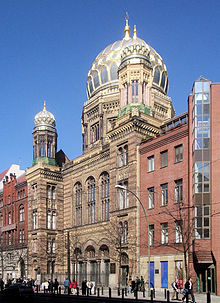New Synagogue (Berlin): Difference between revisions
| Line 17: | Line 17: | ||
== History == |
== History == |
||
The New Synagogue was built to accompany the growing Jewish population in Berlin, in particular, immigrants from the East. As the largest synagogue in Germany at the time, it seated 3,000 people. The building housed public concerts, including a violin concert with [[Albert Einstein]] in 1930. With an organ and a choir, the religious services reflected the liberal developments in the |
The New Synagogue was built to accompany the growing Jewish population in Berlin, in particular, immigrants from the East. As the largest synagogue in Germany at the time, it seated 3,000 people. The building housed public concerts, including a violin concert with [[Albert Einstein]] in 1930. With an organ and a choir, the religious services reflected the liberal developments in the Jewish community of the time.<ref>"Jewish Berlin: Culture, Religion, Daily Life Yesterday and Today." Rebiger, Bill. Jaron Verlag GmbH, Berlin. 2000-2005. Page 26.</ref> |
||
During ''[[Kristallnacht]]'' (9 November, [[1938]]) the ''Neue Synagoge'' was set ablaze. The fire was extinguished, however, and the synagogue, protected as a registered [[architectural monument]], escaped complete destruction. During [[World War II]] it was heavily damaged by Allied bombing during air raids in 1943 . The ruins of the building were finally demolished in 1958 . It was not until the collapse of the [[Berlin Wall]] that reconstruction began. From 1988 to 1993, the remains of the façade were restored as the "Centrum Judaicum" (lit. "Jewish Center"), without being constructed anew. In [[May 1995]], the synagogue was partly revived, though it failed to regain its [[19th century]] glory. After the renovations, only the front of the building with the destroyed dome remained. |
During ''[[Kristallnacht]]'' (9 November, [[1938]]) the ''Neue Synagoge'' was set ablaze. The fire was extinguished, however, and the synagogue, protected as a registered [[architectural monument]], escaped complete destruction. During [[World War II]] it was heavily damaged by Allied bombing during air raids in 1943 . The ruins of the building were finally demolished in 1958 . It was not until the collapse of the [[Berlin Wall]] that reconstruction began. From 1988 to 1993, the remains of the façade were restored as the "Centrum Judaicum" (lit. "Jewish Center"), without being constructed anew. In [[May 1995]], the synagogue was partly revived, though it failed to regain its [[19th century]] glory. After the renovations, only the front of the building with the destroyed dome remained. |
||
Revision as of 05:08, 29 April 2008



The Neue Synagoge (Eng. "New Synagogue") was built 1859-1866 as the main synagogue of the Berlin Jewish community, on Oranienburger Straße. Because of its splendid eastern moorish style and resemblance to the Alhambra, it is an important architectural monument of the second half of the 19th Century in Berlin.
The original building was designed by Eduard Knoblauch. Following Knoblauch's succumbing to illness, Friedrich August Stüler took responsibility for the majority of its construction as well as for its interior arrangement and design. It was inaugurated in the presence of Chancellor Count Otto von Bismarck in 1866 .
Building
The front of the building, facing Oranienburger Straße, is richly ornamented with shaped bricks and terracotta, accented by coloured glazed bricks. Beyond the entrance, the building's alignment changes to mesh with pre-existing structures. The synagogue's main dome with its gilded ribs is an eye-catching sight. The central dome is flanked by two smaller pavilion-like domes on the two side-wings. Beyond the façade was the front hall and the main hall with 3000 seats. Due to the unfavourable alignment of the property the building's design required adjustment along a slightly turned axis.
The Neue Synagoge is also a monument of early iron construction. The new building material (iron was previously not used in building construction) was visible in its use for the outside columns, as well as in the dome's construction. (Iron was also a core component for the now-lost floor structure of the main hall.)
History
The New Synagogue was built to accompany the growing Jewish population in Berlin, in particular, immigrants from the East. As the largest synagogue in Germany at the time, it seated 3,000 people. The building housed public concerts, including a violin concert with Albert Einstein in 1930. With an organ and a choir, the religious services reflected the liberal developments in the Jewish community of the time.[1]
During Kristallnacht (9 November, 1938) the Neue Synagoge was set ablaze. The fire was extinguished, however, and the synagogue, protected as a registered architectural monument, escaped complete destruction. During World War II it was heavily damaged by Allied bombing during air raids in 1943 . The ruins of the building were finally demolished in 1958 . It was not until the collapse of the Berlin Wall that reconstruction began. From 1988 to 1993, the remains of the façade were restored as the "Centrum Judaicum" (lit. "Jewish Center"), without being constructed anew. In May 1995, the synagogue was partly revived, though it failed to regain its 19th century glory. After the renovations, only the front of the building with the destroyed dome remained.
Together with the New Synagogue, the whole Scheunenviertel district experienced a revival, with chic restaurants and boutiques opening up in the area, catering to an increasingly bourgeois clientele.
Notes
52°31′29″N 13°23′40″E / 52.52472°N 13.39444°E
See also
External links
- ^ "Jewish Berlin: Culture, Religion, Daily Life Yesterday and Today." Rebiger, Bill. Jaron Verlag GmbH, Berlin. 2000-2005. Page 26.
